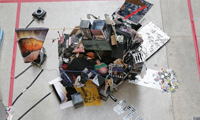 Tate Modern's birthday was a soulless celebration
Tate Modern's birthday was a soulless celebration All the gallery's weekend jamboree showed was that modern does not equal radical. It's a lesson the Labour party needs to learn
Grisly litter ... No Soul For Sale at Tate Modern, a festival to celebrate the gallery's 10th birthday. Photograph: Martin Godwin for the Guardian
Labour now has a unique chance to rethink its attitudes to everything – including culture. Compared with the possibility of being reduced to third place in the election earlier this month, it has had an astonishingly soft landing. What this means is that the soul-searching can be measured, rather than vicious as it was in the 1980s. But soul-searching there must be – and this should include some broad questions about the party's relationship with the world of the arts.
Tate Modern yesterday afternoon was a good place to ask those questions. As part of its 10th-anniversary celebrations, the gallery was hosting No Soul for Sale, a festival of independents. Some critics get their words posted up outside productions of Hamlet; me, I get quoted on an advert for a bouncy castle. "People have come to expect crazy spectacle and interactive fun in the Turbine Hall," said Jonathan Jones on a card distributed by Seattle art venue Western Bridge to promote their contribution, a silvery-grey inflatable cube in which children could jump up and down. At least it offered some good vibrations, which was more than you could say for most of the stalls or exhibits or whatever they were that sprawled along the floor of the hall like the grisly litter of a cultural meltdown.
Honestly, was this a joke? Not so much a festival of independents as a carnival of jerks, this part of the jamboree for the much-touted Bankside anniversary was a massive own-goal, a treat only for the museum's harshest critics. NO FUN, I was raging inside. We had come for a family afternoon by the Thames. It was raining outside, so we were trapped among feedback-playing guitarists, ironic souvenirs, mashed-up magazines and all the other detritus of imaginations that have long since given up. It was like an afternoon with Bob and Roberta Smith's less gifted mates.
How does this relate to Labour's fall, you might ask. From its flirtation with the Cool Britannia pop scene in the 1990s to the Millennium Dome, to what settled into a complacent affiliation with the hipness of contemporary art, New Labour remorselessly and desperately identified itself with cultural modernity. The lousy party at Tate Modern on Sunday afternoon felt like the spectre of the Dome, come to remind us of the strange cultural impostures of the past 13 years.
This is what Labour needs to learn about culture: the modern does not equal the radical. Nor do history, tradition and achievement equal conservatism. Rembrandt is not a conservative – but Tracey Emin did flirt with voting, and, for all I know, did actually vote Cameron. The narrow desire to be the party of Tate Modern (and leave the National Gallery to the rightwingers) was a dry and self-diminishing discipline.
Compare this to the British Museum last autumn, where vast crowds enjoyed a celebration of Mexico's Day of the Dead, with skeleton stilt walkers, candy skulls – and lectures that we listened to eagerly. Labour's obsession with contemporary chic has underestimated the intelligence and curiosity of a country that can no longer be characterised, after this divided election result, as either modern or old-fashioned. In the past, Labour intellectuals claimed the inheritance of John Ruskin. They need to do so again.
 Tate Modern's birthday was a soulless celebration
Tate Modern's birthday was a soulless celebration